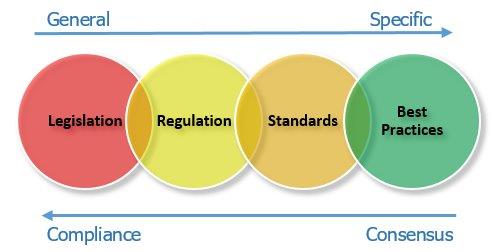Successfully Navigating Regulations, Standards and Best Practices
Print this Article | Send to Colleague
 |
|
| Damage Prevention Legislation Guideline |
Successfully Navigating Regulations, Standards and Best Practices
The tangled web of industry rules, regulations, standards and guidelines can cause confusion for many in the field trying to navigate a project safely. How is that web of information to be deciphered in the "real world" of an excavation site?
It helps to understand rules and regulations as a hierarchy so the relationships between the pieces becomes clearer. The rules governing damage prevention begin with the minimum requirements of legislation and regulations, and proceeds along a path to standards, best practices and guidelines.
Legislation comes from government, is enforceable by law and is typically more general in its requirements. For example, prior to excavating, legislation might demand excavators to determine if underground infrastructure is in the vicinity of their proposed work.
Regulation expands on the law with specific industry requirements, and has a variety of punitive measures in place for non-compliance. For example, the regulation might require that excavators use a provincial notification centre prior to excavation.
Standards are created in a consensus-driven process, with input from experts in various stakeholder roles. They use regulation and legislation as seed documents but are more detailed about requirements. For example, the standard will define what is required by an agency to be considered a provincial notification centre and how much minimum notice is required.
Note: Once incorporated by reference in regulation, a standard is enforceable.
Best practices are driven entirely on consensus by industry professionals. A best practice is a detailed description of the steps required to complete an excavation safely, but does not require compliance. A best practice considers legislation, regulation, standards and expert advice to create a "how to" field manual to follow on-site. For example, a best practice might advise what information should be provided on a locate request or when to request a relocate.
Of the rules governing safe excavations, best practices are reviewed and updated most often. As an industry professional, you have a say in what constitutes a best practice, and are encouraged to introduce new practices or suggest changes to improve existing ones. Learn more about how to request a change at www.albertacga.ca/best-practices.
To participate in the process, join a best practices committee. Send an email to info@albertaonecall.com and volunteer to improve safety in the industry.

